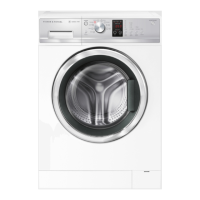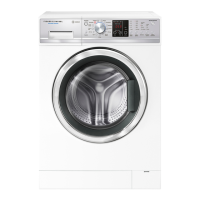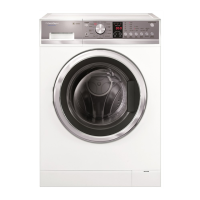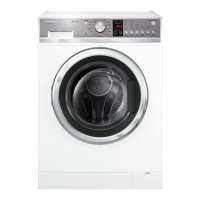Electrical connection
1
This appliance must be connected to a 220V–240V, 50 Hz, sinusoidal, minimum 10A
electricalsupply.
2
Uncoil the power cord, remove and discard the plastic pin cover and plug into a wallsocket.
3
Connect the appliance to an earthed outlet protected by a fuse of suitable capacity.
Check the power cord for damage and make sure it is not squashed or twisted when
installing the washer.
Always remove the power cord from a socket by the plug, not by the cord.
IMPORTANT!
If you are using an extension cord or a portable electrical outlet device (eg multi-socket
outlet box), ensure that it is positioned so that it does not come into contact with water
or moisture. FAILURE TO DO SO MAY RESULT IN DEATH OR ELECTRICAL SHOCK.
Do not touch or operate the machine with wet hands or with bare-feet.
A damaged power cord must be replaced by a Fisher & Paykel service technician, in
order to avoid a hazard. The appliance must not be operated until it is repaired, as
there is risk of electric shock.
Do not operate this machine if it has been damaged during transport. Contact your
Fisher & Paykel dealer or Fisher & Paykel service technician.
SPARE PARTS
Available from your Fisher & Paykel dealer or a Fisher & Paykel service technician.
Hose Inlet Long (2m) Part No. 422680P
Hose Inlet Large Bore Part No. 426123P
Drain Hose Extension Part No. 425627P
Completing the installation
Installation test cycle
IMPORTANT!
Do this before you wash any items in your washer. This is to check that your washer is
installed correctly and that it is functioning correctly prior to use.
1
Turn your washer on by pressing the ‘POWER’ button.
2
Select the ‘Quick’ or ‘Super Quick’ cycle. Ensure the drum is empty and the door closed.
3
Touch the button. The machine will start to fill.
Observe the machine for any problems (eg leaking from the hoses, excess noise
orvibrations).
The washer will beep and display any faults on the screen if there are any problems.
Refer to ‘Before you call for Service’ section at the back of this book.
4
Wait until you see water in the bottom of the drum.
5
Touch to stop the cycle, then press ‘POWER’ to turn the machine off.
6
Press ‘POWER’ again, select the ‘Spin’ cycle and touch .
Check the drain hose is firmly secured to the standpipe or tub, or spigot.
Observe that the machine pumps out the water, and spins.
IMPORTANT!
If there are any problems, you must address these before proceeding with normal use.
The washer will automatically turn off at the end of the cycle if there are no problems.

